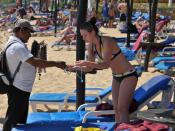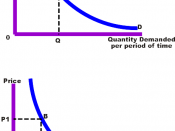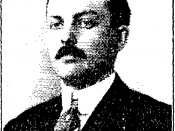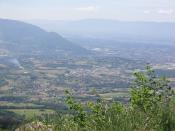Outdoor Sporting Products, Inc. Executive Summary The compensation plan for salespeople at Outdoor Sporting should be changed to reflect the company?s long-term strategy and success. The compensation/incentive plan is not effective as proven by the company?s flat sales despite a growing market for outdoor sporting products.
Other pertinent facts/issues: 1. McDonald strongly believes that each salesperson should be earning $50,000/year.
2. Salespeople currently tend to sell close to home, neglecting the further accounts.
3. Performance is weakly correlated to years of service (except for Campbell). Thus, incentives should not be tied to years of service.
Problems under the current compensation plan: 1. Annual earnings of the company?s salespeople are below industry average.
2. The thresholds for commission pay ($0-300K, $300-500K, $500-1000K) are too large to motivate salesmen to strive to reach the next level.
3. Per diem and traveling expenses are drawn against commission (de-motivator).
4. Sales increase awards award on percentage, which is more motivating to low-volume salesmen than high-volume salesmen.
5. Salespeople have to wait one year to become eligible for the awards, which is a big de-motivating factor for recruiting new, good salespeople.
6. Guarantees result in poor salespeople being retained.
The Comptroller?s plan does not solve major problem of the large sales thresholds. The production manager?s plan alleviates only the geographic imbalance of sales within territories. The consultant?s recommendation only addresses the problem of the poor commission structure.
New Recommended Plan: A new pay structure should be implemented (Appendix A). Under this plan, ?quota? is set at $500,000. Bonus eligibility is subject only to sales level ($500,000), not length of service. After $500,000 level, the salesperson receives an increasing base salary for each additional $100,000 in sales, beginning at $1,000 additional base. Bonuses are also awarded depending on the magnitude of the sales increase from the previous year. This motivates salespeople at all levels. As additional sales become more difficult to realize at higher sales volumes, bonuses become higher, as well as additive. Per diem should be set at the same amounts as the existing per diem, however it should not be drawn against commission. This, will motivate salespeople to work accounts evenly throughout their territories to gain more sales. Guarantees are also eliminated.
Under the old program, the company spent about 6.8% of total sales on paying salespeople (including bonuses, excluding per diems). Under the new program, the company would have spent 9% ($553,556) of total sales (excluding per diems). This assumes the same sales level as the current year. Even considering a conservative estimate of an increase in sales of 20% (new accounts in other areas in underserved territories) would mean revenues of $7.4 million.
Other considerations: 1. Sell more to discounters and thus rethink the pricing policy to reflect this new strategy.
2. Initiate a pull strategy by advertising directly to consumers through local newspaper, radio, and television.
3. Sales training should focus on primary selling features of each product. Too much time is spent on memorizing each feature of each product, taking time away from selling.
Appendix A Sales Base Bonus Eligibility 100,000 10,000 N/A 200,000 20,000 N/A 300,000 30,000 N/A 400,000 40,000 N/A 500,000 (QUOTA) 50,000 Bonus A 600,000 51,000 Bonus A 700,000 53,000 Bonus A 800,000 56,000 Bonus A 900,000 60,000 Bonus A 1,000,000 65,000 Bonus A, B 1,100,000 71,000 Bonus A, B 1,200,000 78,000 Bonus A, B 1,300,000 86,000 Bonus A, B 1,400,000 95,000 Bonus A, B 1,500,000 105,000 Bonus A, B, C 1,600,000 116,000 Bonus A, B, C 1,700,000 128,000 Bonus A, B, C 1,800,000 141,000 Bonus A, B, C 1,900,000 155,000 Bonus A, B, C 2,000,000 170,000 Bonus A, B, C, Other TBD Bonus A ? Salesperson receives 10% of dollar amount of increase in sales over the previous year.
Bonus B ? If salesperson achieves over an increase of 10% in sales over the previous year, he/she receives $10,000 Bonus C ? If salesperson achieves over an increase of 15% in sales over the previous year, he/she receives $15,000



![English: Evans Halshaw car sales, Low Lane, Horsforth This is one of 2 car sales sites, side by side, both run by Evans Halshaw. At this site they sell Fiat and Honda. See also [819697]](https://s.writework.com/uploads/7/77467/english-evans-halshaw-car-sales-low-lane-horsforth-one-2-car-thumb.jpg)

